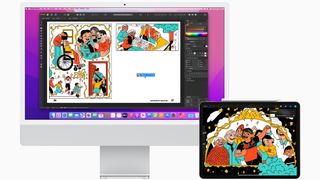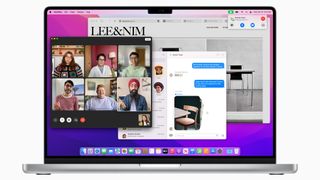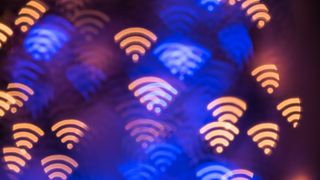macOS Monterey problems: how to fix the most common issues
Iron out any macOS Monterey problems with our tips and tricks and enjoy unparalleled privacy and productivity with Apple's best operating system yet

If you’re experiencing macOS Monterey problems, you won’t be the first. Even though macOS Monterey has now been out for over a year (and its successor, macOS Ventura is now out), there are still issues that could affect your Mac or MacBook.
So, if you have yet to upgrade to macOS Ventura, but you're still getting annoying issues in Monterey, then we can help.
macOS Monterey launched towards the end of 2021 alongside the powerful hardware of the MacBook Pro 14-inch (2021) and MacBook Pro 16-inch (2021), but was also made available for free to those who already had older Macs and MacBooks.
The most commonly reported macOS Monterey problems include battery drain, trackpad and mouse issues, missing features and stuck apps that prevent shutdown. Apple is continuously working to patch these issues, but that doesn’t help you in the meantime. Instead, you can take matters into your own hands and fix these problems with relative ease.
If you’re not suffering from any macOS Monterey problems and are instead considering updating your Mac or MacBook, check out our macOS 12 Monterey review to decide if it’s the right choice for you. However, if your Mac or MacBook can run Monterey, then there's a good chance it can also run macOS Ventura. In that case, we recommend going straight to Ventura. Check out our macOS Ventura review for more information about the new OS, and follow our how to download macOS 13 Ventura guide for step-by-step instructions.
If you want to stick with Monterey, however, that's absolutely fine. While there may be some occasional issues or glitches that pop up when running macOS Monterey, the good news is they are relatively straightforward to fix. That means we can give you some helpful tips to get your machine back up and running in no time. If you don’t see your issue listed here, feel free to follow and tweet the details to us so we can help if possible.
Are you experiencing issues running an older macOS system? No worries there, as we have plenty of guides to help you sort out any problems you might have. Check out our how to fix macOS Big Sur problems for help, or even look at our how to fix macOS Catalina most common issues guide if you’re running an even older macOS.
Get daily insight, inspiration and deals in your inbox
Get the hottest deals available in your inbox plus news, reviews, opinion, analysis and more from the TechRadar team.
macOS Monterey installation problems

How to fix macOS Monterey download problems
One common macOS Monterey problem that people have encountered is that macOS 12 fails to download, with some users seeing an error message that says "Installation failed."
Others, on the other hand, are seeing "The network connection was lost" error messages when they try to download macOS Monterey.
That's not all, either. A few get the following error message: “Installation of macOS could not continue. Installation requires downloading important content. That content can’t be downloaded at this time. Try again later.”
There are a few reasons why you may encounter this issue. It may be because a lot of people are trying to download macOS Monterey at the same time. If you think this is the case, try again later on a non-peak time to see if the download works then. You can also check the live status of the Apple Server to make sure everything is alright on Apple's end.

There should be a section labelled 'macOS Software Update'. If it has a green dot, then there's no issue, but other colors suggest there's a problem with Apple delivering the update.
Not enough disk space to install macOS Monterey
Another of the most common macOS Monterey problems is not having enough space on your computer. Typically, a macOS download fails if you do not have enough storage space available on your Mac.
To make sure you do, open up the Apple menu and click on 'About This Mac.' Select 'Storage' then check to make sure you have enough space on your hard drive. You need at least 15GB free. If you're running low, open up the Apple menu, click 'About this Mac' then go to Storage > Manage and free up some disk space there.
It may also be worth switching from a Wi-Fi connection to an Ethernet cable, to ensure your internet connection is as reliable as possible.
If you’re still having problems downloading macOS Monterey, try to find the partially-downloaded macOS 12 files and a file named ‘Install macOS 12’ on your hard drive. Delete them, then reboot your Mac and try to download macOS Monterey again.
And, if that doesn’t work, try opening the App Store and clicking ‘View My Account’ to see if there is anything in the ‘Unfinished Downloads’ section. You may be able to restart the download from there.
Finally, try logging out of the Store to see if that restarts the download.
How to fix "gateway timed out" error when downloading macOS Monterey
In addition, there’s been a lot of complaints regarding the download stopping, and the system throwing up a "gateway timed out" or "bad gateway" error.
If you are having this issue, try starting your Mac in Safe Mode (hold down Shift on the keyboard while it boots), then try downloading and installing macOS Monterey again.

How to fix macOS Monterey install problems
If you're having problems installing macOS Monterey, you should first make sure your Mac or MacBook is compatible. These are the Mac devices that can run macOS Monterey:
- iMac late 2015 and later
- iMac Pro 2017 and later
- MacBook Air early 2015 and later
- MacBook Pro early 2015 and later
- Mac Pro late 2013 and later
- Mac mini late 2014 and later
- MacBook early 2016 and later
If your Mac or MacBook is older than any of the devices on that list, then it means you won't be able to download and install macOS Monterey. If this means you're considering a new device, then check out our best MacBooks and Macs for more buying advice.
macOS Monterey is stuck on 'Setting Up Your Mac'
If you have installed macOS Monterey, but the 'Setting Up Your Mac' message appears but won't go away, then reboot your Mac or MacBook. This should be perfectly safe, as the installation process should have actually finished.
To do restart your device, press and hold down the power button for a few seconds until the Mac or MacBook turns off. Wait a few more seconds, then turn it back on. Your Mac or MacBook should now boot into macOS Monterey successfully.

If macOS Monterey encounters a problem at the end of installation, and then shows an error message, restart your Mac and press Command + Option + R on your keyboard while the Mac boots to start up the recovery system over the Internet. You can also try Shift + Option + Command + R.
If your Mac continues to fail to boot, follow Apple’s instructions on creating an external Mac startup disk.
It may be worth restarting your Mac in Safe Mode, then trying to install macOS 12 Monterey from there to fix the problem.
General macOS Monterey problems

How to fix macOS Monterey problems
If you're having trouble logging into your Mac or MacBook after installing macOS Monterey, or you're stuck in a loop where you log in, then get logged out again, the following steps might help.
First, restart your Mac and hold down the Command + S keys on your keyboard as it boots up.
This will boot you into a command prompt. Now, enter in the following:
/sbin/mount -uw /Press Enter on your keyboard. Then enter in the following:
rm /var/db/.applesetupdoneThis removes a file, which makes it appear like you're starting macOS Monterey up for the first time. Don't worry, nothing important is getting deleted. Press Enter, then restart your Mac.
You will then be asked to create a new admin user account.
MacBook fans become noisy after updating to macOS Monterey
Some people have been reporting that after updating to macOS Monterey, their MacBook fans have become noticeably louder.
This is likely due to the fact that the MacBook is continuing to work hard behind the scenes updating the rest of the operating system, including updating apps and re-indexing Finder. This can cause the fans to kick in to help keep the MacBook cool. Hopefully, after a few hours the fans should return to normal.

Is macOS Monterey running slowly? Here's how to fix it
Once macOS Monterey is installed on your Mac or MacBook, you may notice that your device is running slower than before.
If macOS Monterey also showed a notification that said "Optimizing Your Mac: Performance and battery life may be affected until completed," then this is normal, as macOS Big Sur is doing things behind the scenes which can initially impact performance.
After a day or so, your Mac should be running just as well (if not better) as before. If you don't see an improvement by then, try restarting your Mac or MacBook.
Another thing to check is to make sure that all of your apps and software are updated to the latest version. If any of them have issues with Big Sur, that could be slowing down your machine.
If you're using a new MacBook or Mac with Apple's M1 chip, or the new M1 Pro and M1 Max chips, you may be using apps that are not optimised for it yet. While Apple's Rosetta tool helps run apps for Intel-based Macs on Apple M1 devices running Monterey, there may still be some performance issues. Keep an eye on the latest versions to see if they have released an update for M1 Macs.
You can also open up the Apple menu and select 'System Preferences'. From the window that appears, click 'Users & Groups'. Select 'Login Items' and then select the apps you want to stop opening at startup and click the small minus sign below the list.
It's also worth making sure all of your apps are updated. Check the App Store for any available updates, or the app's website.
You can also try restarting your Mac to see if that helps. If it doesn't, force-quit any apps that appear to be taking up a lot of RAM. You can identify these by using Activity Monitor (in /Applications/Utilities) to establish what apps and processes are using up the most CPU or RAM. Its CPU tab lists active processes, with a real-time view of what's going on.
To force-quit an item, click it in the Activity Monitor list, click the X at the left of the toolbar, then confirm you want to force-quit.
Also delete the cache. Open the Finder window, select 'Go' from the top menu and select 'Go to Folder'.
In the text box that appears, type /Library/Caches.
Remove the data from inside every folder. Now repeat the process with /Library/Caches (without the symbol). Running the Repair Disk tool from within Disk Utility may also help, and for more solutions check out our How to speed up your Mac guide.
Apps crashing after installing macOS Monterey
If apps have begun crashing and becoming unresponsive, the first thing you should do is update them. Open up the App Store on your Mac and click on 'Updates', then update all apps that have an update waiting.
If that doesn't work, you may need to reinstall the apps. Open the Applications folder and drag the app you want to remove to Trash. Once done, go to the App store, find the app again and reinstall it.
How to fix macOS Monterey battery issues
As with the performance issues above, you may find that at first your MacBook's battery life is a lot shorter. Again, this is probably because macOS Monterey is doing some background work to set itself up – and after a few hours or a day, things should have settled down and your battery life should be back to normal.
If it isn't then make sure all your apps are updated. You can also click the battery icon on the top menu bar, which will show you what apps and processes are taking up a lot of your battery life. Close those and see if the battery improves.
If it does, then make sure the apps in question have been updated, and check any of their settings to see why they would be taking up so much battery life in macOS Monterey.
Some people have also found that switching from Google Chrome to Safari as their default web browser can help with battery issues, as Chrome is notorious for using up a lot of resources which can lead to your MacBook's battery draining faster. Safari, meanwhile, was made by Apple and is better configured to minimize battery use.
A recently reported issue has connected the macOS Monterey 12.2 update to Bluetooth accessories constantly waking a device from sleep mode, which drains the battery overnight, almost completely in some circumstances. It's likely that Apple is currently working on an official patch for this, but you can work around the issue in the meantime by either disconnecting all Bluetooth accessories from the laptop prior to placing it into sleep mode or simply leaving it connected to its charger overnight.
For more advice, visit our how to improve your MacBook's battery guide.
How to fix macOS Monterey boot problems
If you've installed macOS Monterey, but your Mac won't start, then restart your Mac and hold down Command, Option, P and R, which will reset the NVRAM (non-volatile RAM). Note that this does not work with M1 (and M1 Pro and M1 Max) Macs and MacBooks, due to the memory they use.
Hold the keys down until the computer restarts and you hear the startup chime for the second time. Release the keys after you hear the second startup chime. The PRAM will be reset as well.
While in Safe Mode, run Disk Utility to see if that will fix any macOS Big Sur boot problems.
For other ways to fix a Mac that won't start, check out our guides how to Use OS X boot options to troubleshoot your Mac and how to fix a Mac that won't start.

How to fix macOS Monterey Wi-Fi problems
If you're having issues with connecting to the internet, either via Wi-Fi or an Ethernet (wired) connection after installing macOS Monterey, then try starting your Mac in Safe Mode and see if you can connect.
If you can, it means that there's an issue with an app or extension that you have installed. Make sure you have updated your drivers and apps, and keep an eye out for an Apple update in the future.
You could also try turning off the Wi-Fi connection, then turning it back on. Click the Wi-Fi icon in the Menu Bar, then click the toggle to turn it off. Wait a few seconds, then click it again to reconnect.
You can also try forgetting the Wi-Fi settings. To do this, click the Wi-Fi icon and select 'Network Preferences'. Go to the 'Advanced' tab and under 'Wi-Fi' click your network, then the '-' icon. Click 'Remove' to forget the network, then click the network to log back on. Remember, you'll need to know the Wi-Fi password to do so, so make sure you have it handy.
AirDrop not working in macOS Monterey
If AirDrop is no longer working, then try turning off Wi-Fi and Bluetooth on your Mac and then turning them back on. This can sometimes get it to work. Restarting your Mac can also help.
You can also check your AirDrop settings by opening Finder and from the 'Go' menu select 'AirDrop'. Changing the 'Allow me to be discovered by' setting to 'Everyone' can fix AirDrop issues, though make sure you're comfortable using this setting before you turn it on.
Uninstall macOS Monterey
If you're still having issues that just can't be fixed, or you don't like the new operating system, then you can uninstall macOS Monterey and go back to a previous version of macOS. This is an extreme step, but if nothing is fixing your problems, it can at least help you get your Mac or MacBook working again.
Of course, you can then reinstall macOS Monterey later when Apple has issued a fix for your problem.
To uninstall macOS Monterey, turn off your Mac, then boot into Recovery Mode. You can do this by holding down Command + R on your keyboard, then turn on your Mac.
On newer M1-powered Macs, press and hold down the power button until your see startup options. Click 'Options' then 'Continue'. You may need to enter an administrator account password.
From the menu that appears, click 'Disk Utility' then 'Continue'. Pick the hard drive where macOS Monterey is installed and lick 'Erase'. This clears all of your data, so make sure you have backed up files and folders to iCloud or invest in one of the best external hard drives.
Format the drive as APFS, then go back to the macOS Utilities menu and select 'Reinstall macOS Big Sur' and follow the instructions.

Matt is TechRadar's Managing Editor for Core Tech, looking after computing and mobile technology. Having written for a number of publications such as PC Plus, PC Format, T3 and Linux Format, there's no aspect of technology that Matt isn't passionate about, especially computing and PC gaming. Ever since he got an Amiga A500+ for Christmas in 1991, he's loved using (and playing on) computers, and will talk endlessly about how The Secret of Monkey Island is the best game ever made.
